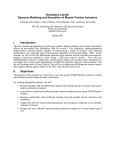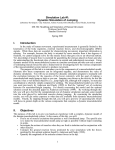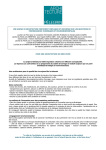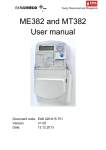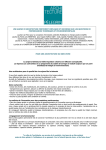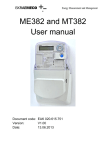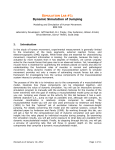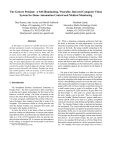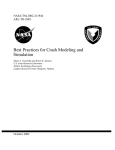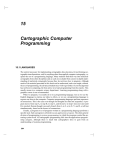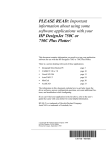Download Simulation #1: - Neuromuscular Biomechanics Lab
Transcript
Simulation Lab #3: Joint Torque Driven Simulation of the Swing Phase of Gait Laboratory Developers: Darryl Thelen, Clay Anderson, Allison Arnold, Silvia Blemker, Scott Delp ME 382: Modeling and Simulation of Human Movement Professor Scott Delp Stanford University Spring 2001 I. Introduction In this class, you are learning how to develop and use biomechanical models to simulate motion. This process involves developing models of musculoskeletal geometry and coupling them with differential equations that describe the dynamics of the system. The differential equations include the equations of motion, muscle activation dynamics, and musculo-tendon mechanics. Biomechanical models often have many degrees of freedom, and therefore it is often infeasible to derive the equations of motion by hand. Instead it is convenient to use a software package such as SD/FAST to generate the code that describes the equations of motion of a system. Such code can be used to numerically solve inverse and forward dynamic problems that arise in the study of human motion. II. Objectives The purpose of this tutorial is to demonstrate the use of SD/FAST to generate and numerically solve differential equations of motion for a biomechanical system. As an example, you will develop a dynamic model of the lower extremity and use SD/FAST routines to analyze the dynamics of the swing phase of gait. By working through this tutorial, you will: • Learn how to generate an SD/FAST system description file for a mechanical system • Create a four link model of the lower extremity • Use SD/FAST to generate source code that describes the equations of motion of your four link model • Use the generated code to conduct both inverse and forward dynamic simulations of the swing phase of gait • Explore the relative contributions of initial conditions and joint torques to the motion of the lower extremity during the swing phase of gait III. Deliverables Turn in computer files from your modeling and simulation work to /home/me382/username/L3, where username is your workstation login. You are the only person who will have read and write permission to this directory during the week or two that this lab is in progress. In addition, hand in a written report that summarizes your findings and addresses the questions that are posed. Please turn in: 1. A written report A Microsoft Word template for the report called lab3_report.doc is available on the BME workstations in /software/nmbl/tutorials/me382/L3. 2. 3. 4. 5. IV. Deposit the following computer files to /home/me382/username/L3 A well-commented SD/FAST system description file for leg_model.sd the four link model of the lower extremity Motion files generated by inverse and forward dynamic inv_swing.mot simulations using driver program main.c provided to you for_swing.mot along with code describing your four link model Modified driver program in which the motion of the pelvis main_mod.c and ankle joints are prescribed and no joint torques are applied Motion file generated via prescribed pelvis and ankle for_passive_swing.mot motion with no joint torques applied at the hip or knee Input Files 1. Data Files /software/nmbl/tutorials/me382/L3/gait.mot SIMM motion file of the gait kinematics of a young adult walking at a natural cadence. Data file includes the generalized coordinates describing pelvis and leg motion during one gait cycle (collected in Biomotion Laboratory, BME Division, Stanford University) /software/nmbl/tutorials/me382/L3/gait_swing.mot SIMM motion file of the kinematics of the swing phase of gait. File includes the generalized coordinate, generalized speeds and accelerations of the pelvis and lower limb during the swing phase of gait. /software/nmbl/tutorials/me382/L3/gait_swing.dat Same as gait_swing.mot without the motion file header information. This data file is read by the main executable program and used to conduct the inverse dynamics simulation. 2 2. SIMM Model Files /software/nmbl/tutorials/me382/L3/leg_model_2d.jnt SIMM joint file used to animate the leg motion. A 3D leg model (Delp et al. 1990) included in SIMM was adapted for this model by adding generalized coordinates for the pelvis and removing non-planar degrees of freedom. 3. Program Files /software/nmbl/tutorials/me382/L3/main.c Driver program that performs inverse and forward dynamic simulations of the swing phase of gait using SD/FAST generated code. Reads in experimental gait data and outputs motion files for visualization in SIMM. 4. SD/FAST /software/nmbl/tutorials/me382/L3/sdfast Directory containing all files referred to in tutorials 1-4 of the SD/FAST manual. V. Getting Started Copy all of the input files into your directory. # # # # # mkdir L3 cd L3 cp /software/nmbl/tutorials/me382/L3/* . mkdir sdfast cp /software/nmbl/tutorials/me382/L3/sdfast/*.* sdfast You should also create the SD/FAST general purpose library (sdlib.c) which will be used in all of your simulations. This file is independent of your particular model and application, and only needs to be generated once. Since SD/FAST is only licensed to run on the workstation hill.stanford.edu, you will always need to remotely login to hill prior to using SD/FAST to generate code. You can use the following steps to create the library file. 1. Remotely log on to hill. # kinit username (where username is your login ID on SUNET, you may not have to do this step if your BME and SUNET login ID’s are the same) # klogin –l username hill (where username is your BME login ID) 2. Create the library file # sdfast –gl –lc (produces a C version of the library: sdlib.c) # sdfast –gl –lf (produces a Fortran version of the library: sdlib.f) 3 VI. SD/FAST Tutorials Using SD/FAST to simulate a model of a dynamic system involves the following basic steps: 1. Generating an SD/FAST system description file for your model. 2. Running SD/FAST to generate code that describes the equations of motion of your system. 3. Combining SD/FAST generated code and SD/FAST routines within a program to numerically simulate the system under user-defined conditions. Your should read and complete tutorials 1 and 2 in the SD/FAST users manual to become familiar with these steps: • Tutorial 1: Introducing SD/FAST • Tutorial 2: Simple Pendulum A pdf version of the manual is available under the resources section of the class web page (www.stanford.edu/class/me382). Paper versions of the manual are available in the computer laboratory. Tutorial 1 provides a broad overview of SD/FAST. Tutorial 2 asks you to write, compile and run fortran code to simulate a dynamical system. All SD/FAST routines have both fortran and C versions, with the syntax for each type of call described in the manual. When completing Tutorial 2, you can use fortran as described or comparable commands in C. If you desire to use C, please see pages R-1 through R-3 of the manual for a summary of differences in the fortran and C implementations of SD/FAST routines. Note that in the remainder of the class, you will be using C code for all your programs. As you complete each section of Tutorial 2, feel free to try variations to cover aspects of SD/FAST or the dynamical model that interest you. If you have time, you may find it useful to look through SD/FAST tutorials 3 and 4 to get an idea of some of the more advanced modeling capabilities of the software. SD/Fast has a specific, compact notation for defining body segments, describing joint locations and creating joints. Body segments are defined based on their inertial properties, specifically the mass and mass moments of inertia. Joint locations are defined via body-fixed local vectors relative to the body centers of mass (Figure 1). A number of pre-defined joints (e.g. pin, slider, ball) exist in SD/FAST and can be used to describe relative motion between bodies. Please see the manual for a complete description of the types of joints that can be modeled. Inboard Body itj itj – Inboard to Joint Vector joint btj btj – Body to Joint Vector Outboard Body Figure 1. In SD/Fast, each body articulates with respect to an inboard body by a joint of a particular type. The position of a joint relative to the center of mass of the body is defined by the Body-To-Joint vector. An Inboard-To-Joint vector gives the position of the joint relative to the Inboard Body’s center of mass. 4 VII. Planar Leg Model In this tutorial, you will be using a planar leg model to simulate the swing phase of gait. The model has 4 segments, 4 joints and six generalized coordinates as described in Figure 2. The four segments are the pelvis, femur, tibia and calcaneus (foot). The segment names are selected to correspond with the SIMM motion file that will be used to animate your simulations. The pelvis is connected to ground via a planar joint that allows translation and rotation in the xy plane. The hip, knee and ankle joints are modeled as pin joints with rotation axes aligned with the global z axis [Figure 2]. -q3 q1 q1, q2 – horizontal and vertical position of pelvis, midway point between ASIS q3 – pelvis angle with respect to the vertical q4 – hip flexion angle q5 – knee extension angle q6 – ankle dorsiflexion angle q4 q2 -q5 y x q6 Figure 2. Four segment model of the lower extremity, which includes the pelvis, femur, tibia and calcaneus (foot). The pelvis is attached to ground by a 3 dof planar joint which allows translation and rotation in the plane. The hip, knee and ankle joints are assumed to be frictionless pin joints. Six generalized coordinates are used to uniquely specify the joint positions. 5 VII-A. Define Inertial Properties Creating the SD/FAST description file for the leg model requires estimating the length and inertial properties of the body segments. Specifically you need to specify the segment masses, locations of the joints relative to the mass centers and the mass moments of inertia. Since you cannot directly measure segmental inertia properties of humans, it is necessary to estimate these properties through indirect methods. Researchers in the field of anthropometry, the study of the physical dimensions of the human body, have accumulated estimates of the length and inertial properties of human body segments. These estimates have been obtained using various techniques including direct measurements from cadavers and the coupling of volumetric measurements with body density tables. The inertial parameters of the pelvis and foot segments have been estimated for you from the anthropometric data reported by McConville et al. 1980 (Table 1). A body mass of 75 kilograms and a height of 1.77 meters were assumed to scale the anthropometry data. You are to complete the missing values in Tables 1 and 2 by scaling the anthropometric data accumulated by Winter (1990), which is provided to you in a separate handout. Note that your model is planar so only the Iz compoments of the mass moments of inertia will be important. However the system description file requires values of Ix and Iy as well. Please make and document appropriate assumptions used in estimating Ix and Iy. Table 1. Segmental inertia parameters are relative to a local xyz reference frame fixed at the segmental center of mass. In an upright reference configuration, both the local and global reference frames are aligned such that x points anteriorly, y points superiorly and z points laterally. Segment M (kg) Pelvis 11.77 Femur 7.76 Tibia 3.71 Foot 1.45 Ix 0.1030 I (kg-m2) Iy 0.0871 Iz 0.0579 0.0015 0.0040 0.0040 Table 2. Joints used in the planar leg model. Pelvis is attached to ground via a planar joint. Hip, knee and ankle are assumed to be pin joints. Joint Type Body Inboard btj (m) itj (m) body Pelvis_ground Planar (3 dof’s) Pelvis Ground Hip Pin (1 dof) Femur Pelvis Knee Pin (1 dof) Tibia Femur Ankle Pin (1 dof) Foot Tibia x y z x y 0.0707 0.000 0.000 0.000 0.000 0.000 -0.034 0.020 0.000 0.000 -0.243 0.000 itj – inboard to joint position vector, btj – body to joint position vector (See Figure 1) 6 z VII-B. Create and Process SD/FAST Description File Create an SD/FAST system description file that describes your planar leg model. You can use whichever text editor you are most comfortable with (jot, vi, emacs are all available on the unix machines). Save the model description file as leg_model.sd. The next step is to generate code that can be used to simulate the system. In a unix command window, change to the directory where your model description file is. Enter the following command to use SD/FAST to generate code describing your system. Recall that you must be logged onto hill.Stanford.edu. # sdfast –d –lc leg_model.sd Notes on arguments: –d –lc –h specifies double precision code specifies output language as c another useful argument – help SD/Fast will create three model specific files by processing your system description file. Routines in these files will be called during inverse and forward dynamic simulations: leg_model_dyn.c leg_model_sar.c leg_model_info Dynamic simulation code Simplified analysis routines Information file VIII. Torque Driven Simulation of Swing Phase of Gait In this example, SD/FAST generated code and routines will be used to perform inverse and forward dynamic simulations of the swing phase of gait. • Inverse dynamics analysis: given q1…q6 and the first and second time derivatives, calculate the moments at each of the joints necessary to generate the prescribed motion • Forward dynamics analysis: use the initial generalized coordinates q1…q6 and initial generalized speeds u1…u6 together with the joint moments determined via inverse dynamics to numerically integrate the equations of motion. Complete the following steps to perform an inverse and forward dynamics analysis of the swing phase of gait. 1. Use SIMM to visualize the lower extremity kinematics during the swing phase of gait Change to lab 3 directory : # cd L3 Start SIMM: # simm2 Use the preferences tool to change: /software/simm/demo/bones Bone file path: Load the joint file: leg_model_2d.jnt Joint file: Load the gait cycle motion: Motion file: gait.mot 7 Load the gait swing phase motion: Motion file: gait_swing.mot Animate the motion files Use plotmaker to create a plot of the hip, knee and ankle angles during swing Note: The leg model you are using to animate and plot the simulation results has a 2D planar knee joint that allows for sliding-rolling motion between the femur and tibia. While it can be effectively used to visualize the simulated motions, the model does not strictly correspond to the SD/FAST model you are creating and simulating. In future labs, you will learn how you can use SIMM/Pipeline to include more complex joint kinematics within your dynamic simulations. 2. Use an editor to open main.c Read through the steps of the program to begin to become familiar with the layout of the program. You will need to modify the code later so it is worthwhile to begin understanding it. 3. Compile and link your program by running a makefile that has been created for this lab # make 4. Makefile generates an executable program which you can run by entering # swing 5. Two output motion files are created. You should load both of these into SIMM along with the leg_model_2d.jnt file. inv_swing.mot – contains the kinematics (gen coordinates, gen speeds and accelerations) and also the joint torques that were calculated using inverse dynamics – contains the kinematics (gen coordinates, gen speeds and accelerations) that were simulated from the joint torques using forward dynamics for_swing.mot Motion Curves hip_angle_torque, knee_angle_torque, ankle_angle_torque 40 30 20 10 0 -10 -20 -30 -40 60 70 80 90 100 fordyn_gait_swing (5) fordyn_gait_swing (5): hip_angle_torque fordyn_gait_swing (5): knee_angle_torque fordyn_gait_swing (5): ankle_angle_torque Figure 3. Hip, knee and ankle torques calculated from an inverse dynamics analysis of the swing phase of gait. 8 6. Analyze the results of the inverse dynamics simulation: • Plot the hip, knee and ankle moments. Your results should be similar to those shown in Figure 3. • Intuitively, how do you believe the joint moments are contributing to the observed motion? (e.g. how does the hip moment flex or extend the hip, knee and ankle?) • What is the physical meaning of the generalized torques associated with the pelvis degrees of freedom (pelvis_tx_torque, pelvis_ty_torque, pelvis_rotation_torque)? 7. Compare the results of the inverse and forward dynamic simulations • Use plotmaker to overly plots of the actual and forward dynamic simulated hip, knee and ankle angles • Do they agree? Why or why not? Hint: Please see Risher et al. [1997]. • After determining the underlying source of the discrepancy, describe appropriate modifications that would be necessary to ensure that the forward dynamics solution agrees with experimental data. IX. Passive Simulation of the Swing Phase of Gait Many investigators have assumed that the swing phase of gait can be achieved via a relatively passive leg during normal speed gait [e.g. Mochon and McMahon, Ballistic Walking, J Biomech 13:49-57, 1980]. Your task is to turn off joint torques, prescribe pelvis and ankle motion, and then determine a set of initial velocities for the hip and knee that can achieve as nearly as possible swing motion passively. In the program main.c, you will need to modify the code such that the accelerations associated with the pelvis (_tx, ty, rotation) and ankle (_angle) degrees of freedom have prescribed accelerations. We recommend that you first implement a simulation that uses prescribed motion at the pelvis and ankle together with applied hip and knee torques to recreate the forward dynamic simulation. Doing this involves the following steps: • Change your system description file such that pelvis and ankle degrees of freedom can be set to have prescribed motion at runtime (see pages R77-R79 in the SD/FAST manual). Use SD/FAST to regenerate the model code with the new description file. • Rename the driver program main_mod.c • Change the code to write the forward dynamics simulation to a motion file named for_passive_swing.mot. • Comment out the inverse dynamics portion of the program since you will only be doing forward dynamics. • Within SDUMOTION, prescribe the accelerations of pelvis and ankle q’s to experimental values read in from the gait_swing.data file (see commands sdpres and sdpresacc). • Within SDUFORCE, modify the code to apply torques only about the hip and knee. • Rerun your simulation. 9 Running this simulation, you should be able to produce a simulation similar to that you got when you applied torques for each of the generalized coordinates. After verifying this, you should turn off the hip and knee torques and then vary the initial hip and knee velocities to try to achieve the swing motion passively. • Within SDUFORCE, comment out any applied torques. • Prior to the forward dynamic simulation, alter the initial hip and knee angular velocities in the state vector y. • Rerun your simulation trying different initial knee and hip angular velocities until you get a swing motion that is similar to experimental data. How good of agreement were you able to obtain between the actual and passive swing motions? Are there any physical factors not included in your model that might need to be included to get your passive swing kinematics to agree better with experimental data? Submit your modified driver program and output motion file as described in the deliverables sections. X. Stretches If you have time, you can use the model to try to achieve the following: XI. • Implement appropriate corrections such that the joint angles determined from the forward dynamics simulation agree exactly with experimental data. • Allowing passive motion at the ankle, determine a set of initial hip, knee and ankle velocities that result in passive motion that agrees with experimental data. • Implement passive ligament torques at the knee to restrict hyperextension. References Delp SL, Loan JP, Hoy MG, Zajac FE, Topp EL and Rosen JM (1990) “An interactive graphicsbased model of the lower extremity to study orthopaedic surgical procedures”, IEEE Trans Biomed Eng, 37:757-67. Hollars MG, Rosenthal DE and Sherman MA (1994) SD/FAST User’s Manual, Version B.2, Symbolic Dynamics, Inc., Mountain View, CA. McConville JT, Clauser CE, Churchill TD, Cuzzi J and Kaleps I (1980) “Anthropometric relationships of body and body segmenet moments of inertia,” Technical Report AFAMRLTR-80-119. Air Force Aerospace Medical Research Laboratory, Wright-Patterson AFB, Ohio. Mochon S, McMahon TA. (1980) “Ballistic Walking,” J Biomech 13:49-57. Risher DW, Schutte LM and Runger CF (1997) “The use of inverse dynamics solutions in direct dynamics simulations,” J Biomech Engin 119:417-422. Winter DA, 1990, Biomechanics and Motor Control of Human Movement, 2nd Ed., Wiley, New York, NY. 10












